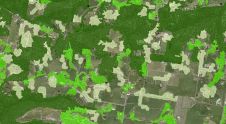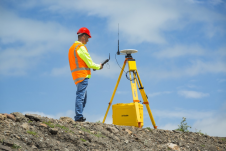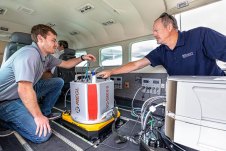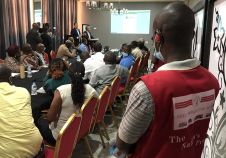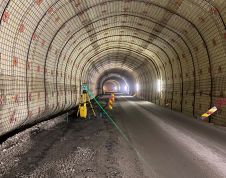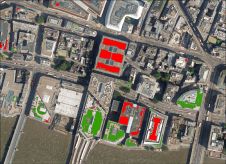The African Geodetic Reference Frame
The African Geodetic Reference Frame (AFREF) was conceived to unify the patchwork of geodetic reference frames and vertical datums in the 54 countries in Africa. A common reference frame is intended to make it easier to co-ordinate planning and development activities within countries and across national boundaries. This article looks at the progress made from the year 2000 up to the end of 2015.
(By Richard Wonnacott, Umvoto Africa (Pty) Ltd, and Andre Nonguierma, United Nations Economic Commission for Africa)
所有地理发行都需要统一的坐标参考框架,但是非洲的54个国家 /地区中的每个国家都有其自己的大地参考框架。此外,一些国家的参考框架基于不同的数据。非洲的参考系统和框架的拼凑而成,很难协调国家和跨国家边界内的计划和发展活动。非洲大地参考框架(AFREF)于2000年构想,以统一非洲的大地参考框架和垂直基准。
Objectives of AFREF
一旦完全实现,参考帧将consist of a network of continuously operating GNSS reference stations distributed throughout Africa at a spacing of at most 1,000km. The objectives of AFREF can be separated into geodetic objectives and knowledge building objectives.
The geodetic objectives are:
- 定义非洲大陆参考系统。Establish and maintain a unified geodetic reference network as the fundamental basis for the national 3D reference networks fully consistent and homogeneous with the global reference frame of the International Terrestrial Reference Frame (ITRF)
- Realise a unified vertical datum and support efforts to establish a precise African geoid, in concert with the African Geoid project activities
- Establish continuous, permanent GPS stations such that each nation or each user has free access to, and is at most 1,000km from, such stations
- Determine the relationship between the existing national reference frames and the ITRF to preserve legacy information based on existing frames.
The knowledge building objectives are:
- Provide a sustainable development environment for technology transfer, so that these activities will enhance the national networks and numerous applications with readily available technology
- Understand the necessary geodetic requirements of participating national and international agencies
- 协助建立国内专业知识,用于实施,运营,处理和分析现代地球技术,主要是GPS。
Previous attempts
In 1981 a project was proposed to use the United States Navy Navigation Satellite System (NNSS) to unify the geodetic datums of Africa. This project was known as the Africa Doppler Survey (ADOS), after the Doppler principle of measurement used in the NNSS. ADOS was initiated by the International Association of Geodesy (IAG) in conjunction with the African Association of Cartography (AAC), the United Nations Economic Commission for Africa (UNECA) and the Regional Centre for Mapping of Resources for Development (RCMRD). Observations were carried out by African national mapping organisations (NMOs) and international geodetic organisations under bilateral agreements. Although nearly 300 zero-order points had been established within the project by the end of 1986, the goal to unify the geodetic datums in Africa was not met. The main reasons for this were:
- 进行观察的物流同时被证明确实很困难,并且限制了合适的数据的数量
- the rationale was not fully understood by participating African countries, resulting in a lack of motivation and enthusiasm for the project
- the project was planned almost entirely by the IAG and the international community with little input from African countries
- there were no set observing standards and procedures, resulting in observations of unacceptable standard
- the bilateral agreements between countries and sister organisations did not always materialise.
AFREF的组织
Although ADOS did not entirely meet its objectives, it did serve to provide a number of valuable lessons which have been carried into AFREF. With the introduction of global navigation satellite systems (GNSS) and the establishment of the International GNSS Service (IGS) it became possible to execute a project such as AFREF without the major logistics headache of having to observe all points simultaneously in a network as with ADOS.
首次在2000年在南非开普敦举行的全球空间数据基础设施(GSDI)会议上首次提出了使用GNSS统一非洲参考框架的概念。从那时起,已经举行了许多会议和研讨会来解决AFREF。2002年,AFREF被正式作为UNECA中的项目,并签署了意图宣布宣布和支持纳米比亚温得和克几个非洲NMO的负责人的主管。
Unlike ADOS, which was driven by the international community, the primary principle of AFREF is that it is being designed, managed and executed by and for African countries with assistance from the international community. At the same time, data from AFREF contributes to the global pool of GNSS data through the IGS and provides a better understanding of global geodesy and geophysics.
AFREF stations
最初的进度非常慢,很少建立站。2005年,非洲只有15个IGS批准的站(见图1)。然而,自2006年以来,安装永久GNSS基站一直取得了稳步的进展。贡献站的增加很大程度上可以归因于科学群体,例如非洲阵列,Scinda,Amma-GPS等,后者与地震仪,气象传感器等共同列入了永久性GNSS接收器。此外,许多国家已经安装了自己的永久网络,并从这些网络中获取了AFREF的数据。
Although the stations are generally well spread out across the African continent, there is a lack of stations in the area from Angola through Central Africa into Sudan and across North Africa. A number of stations are known to be in some of these areas but data from them is not openly available.
操作数据中心
In 2009 the AFREF Operational Data Centre (ODC) was established to process the data from the permanent GNSS base stations. By the end of 2015 there were approximately 65 stations in total contributing data to the ODC. On any given day, there are approximately 45 stations streaming open data (free of charge and openly available) to the ODC (see Figure 2).
The results of two weeks of measurements at 50 stations in December 2012 were processed into an initial reference frame for ITRF 2008 Epoch 2012 Day 340 23h 59s (GPS Week 1717). Four processing centres, either in Africa or with African affiliations, processed the collected data and computed a set of static AFREF coordinates. The centres involved were:
- HartRAO in South Africa
- 葡萄牙的Segal(UBI/IDL)
- Directorate of Surveys & Mapping in Tanzania
- Ardhi Univ in Tanzania.
The Institut Géographique National (IGN) in France combined the results of these four independent computations. The results were statistically analysed, which produced a weighted root mean square (RMS) of approximately 3.0mm in Longitude and Latitude and 7.5mm in Up for all the coordinates. The resulting coordinates are available on the AFREF ODC (ftp.afrefdata.org) (see Figure 3).
Knowledge building
AFREF的目标之一是“为技术转移提供可持续发展的开发环境”,而AFREF肯定已经实现了,当人们考虑到现在有多少非洲研究人员使用AFREF数据时,将其使用在广泛的地理学学科中。在肯尼亚内罗毕的区域中心(RCMRD)和尼日利亚Ile-Fife航空航天调查(RECTAS)的区域培训中心以及其他各种其他中心,在区域中心进行了许多研讨会(RCMRD)和培训区域培训中心举行了许多研讨会。非洲。GNSS站硬件和安装领域的专家已经对培训进行了培训,连续操作参考站(CORS)网络的管理以及从网络派生的数据处理。自2006年以来,RCMRD定期发布了AFREF新闻通讯,许多非洲作家的贡献。许多与AFREF相关的同行评审论文已在受人尊敬的国际期刊上发表或在国际会议上发表。本着AFREF是一个非洲项目,由非洲人在国际社会的协助下设计,管理和执行,可以肯定地说,该项目已经实现了这一目标。
Challenges
AFREF has been slow to move forward since its inception in 2000. In spite of this, progress has been made with the establishment of the ODC and the computation of a set of static co-ordinates for over 50 stations based on the ITRF, thus creating a uniform reference frame for Africa. Apart from the coverage of CORS across Africa the co-ordination of activities, such as the installation of references stations in close proximity to one another, remains problematic and needs attention. As with any project of this magnitude, obtaining funding and political buy-in from national leaders is a challenge.
致谢
AFREF would not exist without the support of many organisations and individuals including IGS, IAG and UNECA, without whose continuing support from the start this project would never have reached the stage at which it is now.
Further Reading
- Wonnacott, R., 2005. AFREF: Background and Progress towards a Unified Reference System for Africa. Proceedings of International Federation of Surveyors (FIG) Working Week, Cairo, Egypt.
- Wonnacott,R.,Ezibalike,C.2009。AFREF - 非洲统一的大地测量参考框架。Civil Engineering SurveyorGIS/GPS supplement, Inst of Civil Engineering Surveyors.
Biography of the Authors
Richard Wonnacott retired from the Chief Directorate: National Geospatial Information, South Africa in 2013 where he was responsible for the national control survey network including the network of permanent GNSS base stations, TrigNet. He was a member of the Governing Board of the IGS from 2006 until 2013 and the Executive Committee of the IAG from 2007 until 2015 and a member of the AFREF Steering Committee from 2006.
Andre Nonguierma has focused for more than 20 years on leveraging the use of geospatial data, information and analytics for strategic decision-making. He is the officer-in-charge of the Geoinformation Systems Section at UNECA where he has worked for eight years on spatial data infrastructures in Africa.
Figure Captions
Figure 1,The South African TrigNet station DEAR which is also an IGS and AFREF station. DEAR has been co-located with a weather station.
图2,2015年运营数据中心数据库中AFREF电台的每日记录。
Figure 3,AFREF stations (red triangles) and global stations (blue triangles) used to compute static coordinates for AFREF based on ITRF 2008 (epoch 2012.934).
Figure 4,在肯尼亚举行的2015年AFREF和GNSS数据处理培训的参与者(资料来源:RCMRD)。
Figure 5,2006年在南非开普敦举行的AFREF研讨会的参与者。参与者包括来自IAG,IGS,NGS,NGA,IGN和许多非洲国家的代表。
Make your inbox more interesting.Add some geo.
Keep abreast of news, developments and technological advancement in the geomatics industry.
免费注册













